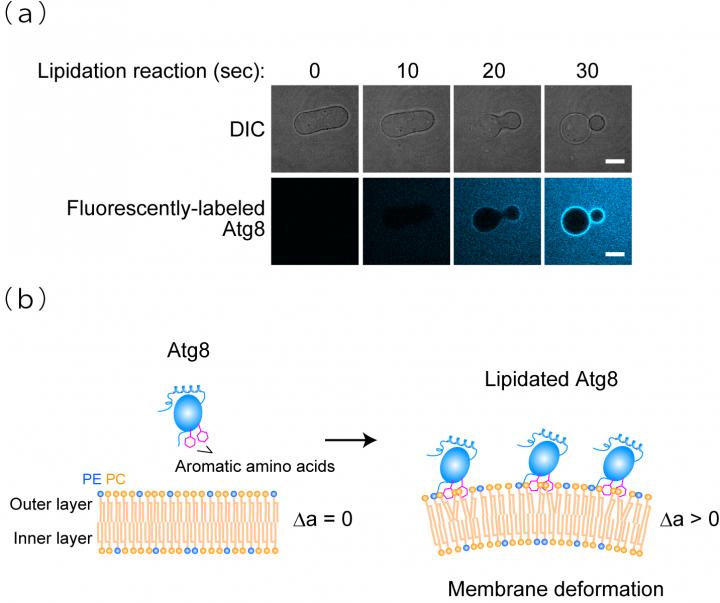Revealing the molecular role of the most famous autophagy factor

Credit: © Nobuo N. Noda
Drs. Nobuo Noda (Director) and Tatsuro Maruyama (Researcher) et al. at the Institute of Microbial Chemistry (BIKAKEN, Tokyo, Japan) discovered that lipidated Atg8(1), the most famous factor that mediates autophagy, has membrane perturbation activity and elucidated that this activity is responsible for efficient autophagosome formation.
Autophagosome formation is an essential step in determining the target of degradation in autophagy, which is one of the mechanisms of intracellular protein degradation. It is known that lipidated Atg8 plays a primary role in autophagy processes; however, the molecular function of lipidated Atg8 on the autophagy-related membranes remains unknown.
The research group demonstrated through in vitro experiments that yeast Atg8 exhibits membrane transforming activity. Moreover, on examining the three-dimensional structure of lipidated Atg8 by solution NMR spectroscopy(2), they found that lipidated Atg8 interacts with the membrane via two aromatic amino acids(3). In addition, they found that mutant aromatic amino acids resulted in the loss of the membrane transforming activity of lipidated Atg8 in vitro, inhibited the autophagosome formation in yeast, and attenuated autophagy in mammalian cells. Consequently, they revealed a novel mechanism wherein lipidated Atg8 perturbs and transforms membranes through direct interaction, thereby promoting autophagosome formation.
The elucidation of the molecular role of the main autophagy factor, Atg8, which has been a long-standing issue in the field of autophagy, holds promise in accelerating research that will contribute to a complete understanding of the molecular mechanisms of autophagosome formation. Furthermore, it is expected to promote research and development for treating and preventing various diseases through the artificial control of autophagy by deepening our understanding of autophagosome formation mechanisms.
The present research was conducted in collaboration with the group of Drs. Hitoshi Nakatogawa (Associate Professor, Tokyo Institute of Technology), Yoshinori Ohsumi (Honorary Professor), Tomotake Kanki (Professor, Niigata University), Masaaki Komatsu (Professor, Juntendo University), and Ichio Shimada (Team Leader, RIKEN) in JST Strategic Basic Research Programs (CREST).
(1) Lipidated Atg8
The functional state of Atg8 involves its covalent conjugation with a phospholipid via enzymatic reactions. Since lipidated Atg8 is abundant in the membranes of autophagosomes and their precursors, it is widely utilized as the main autophagy marker protein in autophagy research.
(2) NMR spectroscopy
Atomic nuclei in a strong magnetic field interact with electromagnetic waves having a specific frequency (named resonance frequency), which reflects the nuclear property and chemical environment. NMR spectroscopy is a technique used for obtaining information regarding the structure and property of compounds by detecting the electromagnetic waves as NMR signals. NMR is an abbreviation for Nuclear Magnetic Resonance.
(3) Aromatic amino acids
Aromatic amino acids, such as tryptophan, tyrosine, and phenylalanine, have an aromatic side chain. It is known that buried aromatic amino acids contribute to the stabilization of protein folding, whereas exposed aromatic amino acids mediate interactions with other proteins and membranes.
###
Media Contact
Noda Nobuo N.
[email protected]
Original Source
https:/
Related Journal Article
http://dx.




